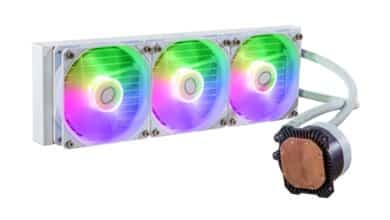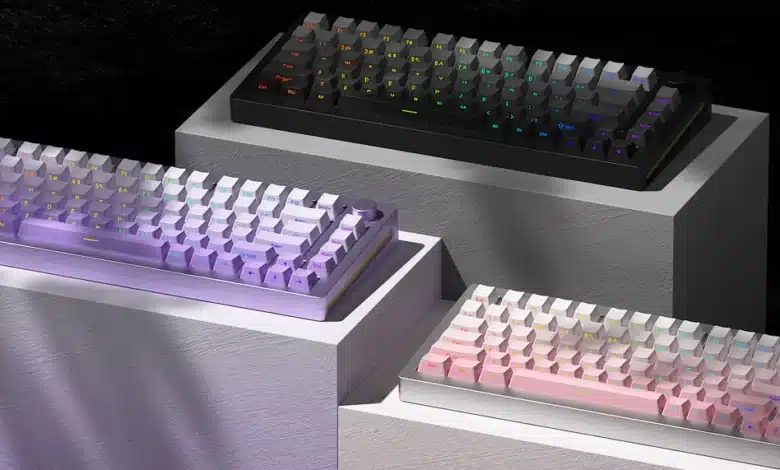
I have already been able to test various keyboards from Akko and observe the growing presence of the Chinese manufacturer on the mechanical keyboard market. Akko has now added keyboards from another brand to its product portfolio. The manufacturer is called MonsGeek and the new M1W keyboard is the first aluminum keyboard sold by Akko that I was able to test. In this MonsGeek M1W review, I will find out whether the entry into the premium segment has been successful.
Scope of delivery
- USB-C to USB-C cable
- 2.4 GHz dongle
- Key cap puller
- Keyswitch puller
- TPU stabilizers
- Teflon pads
- Wrench
- Instruction manual
The MonsGeek M1W keyboard is supplied in plain and sturdy cardboard packaging. In addition to the keyboard itself, the scope of delivery includes the following parts: a black detachable USB-C cable, a keycap puller, a puller for the switches, a 2.4 GHz USB dongle, additional TPU stabilizers, Teflon pads, a suitable key for the screws used and a user manual. The USB-C cable is a coiled cable with a length of approx. 1.80 meters.
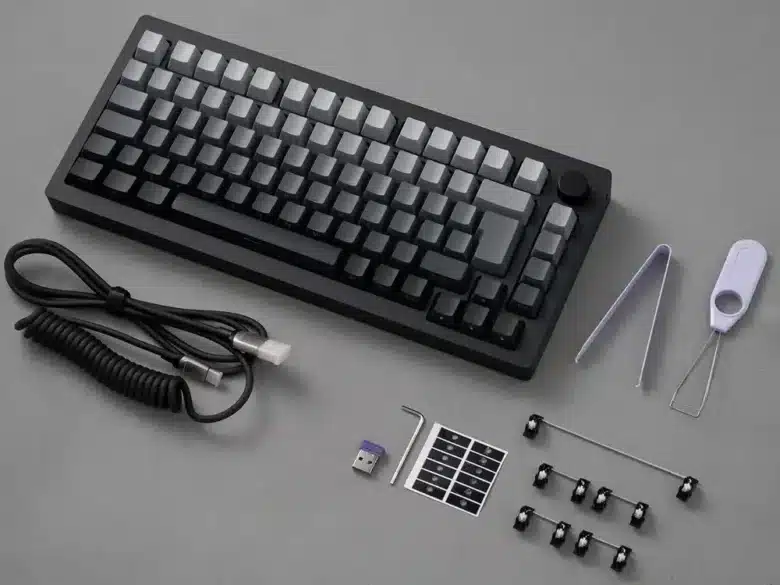
Overall, the scope of delivery is very extensive and includes all the necessary accessories to be able to fully customize the keyboard afterwards – be it new switches, keycaps or stabilizers.

Design & workmanship
- Solid black aluminum housing
- Minimalist design
- ISO-UK layout
- Good workmanship of the individual parts
- Keycaps in gray tones with side lettering
- South-facing RGB
The absolute highlight of the MonsGeek M1W for me is the aluminum housing. The weight and cool feel of the case immediately give the keyboard an aura that says: Premium!
Design
In general, the design of the MonsGeek M1W keyboard is extremely minimalist – underlined by the black aluminum housing and the double-shot PBT keycaps in various shades of grey. A special feature is the lettering, which is not on the top of the keys as usual, but on the side of the keycap facing the user. This gives the keyboard an unmarked and very elegant appearance. The M1W is available in UK ISO layout. This means that the shape and arrangement of the keys corresponds to the German ISO-DE layout. The lettering, however, is British. This means that every button is present and in the “right” place, but the labeling differs. If you select the German layout on your connected device, you can type as usual – as long as you know where each key is located.

The simple design makes the south-facing RGB backlighting stand out all the more. The keycaps are provided with translucent lettering that lights up in the respective colors when the backlight is switched on. Without backlighting, however, the lettering is barely visible. This is not a problem for experienced “typists” as they know the key layout by heart. However, those who are not so familiar with it will find it rather difficult without backlighting. The MonsGeek M1W looks very aesthetically pleasing even without RGB lighting – and the battery naturally lasts longer.
Workmanship
The MonsGeek M1W keyboard is very compact with a size of around 30 cm x 15 cm and a height of just over 3 cm, but weighs an impressive 2.2 kg. It fits perfectly on small desks and offers plenty of space for a mouse. Thanks to its heavy weight and the four rubber feet on the underside, it stays firmly in place. In general, the MonsGeek M1W keyboard is of high quality and has no defects.

The quality of the built-in stabilizers, which prevent the larger keys such as the space bar, Enter key etc. from wobbling, is also above average. Only the stabilizers of the space bar started to make rattling noises after a few months of using the MonsGeek M1W Review. However, this is nothing that can’t be remedied with a little grease.
Features
- Rotary knob
- 20 different RGB modes
- Multimodal operation (cable, Bluetooth, 2.4 GHz)
- Support for Windows, Linux, Android, MacOS
- Hot-swap
- N-key rollover
- MonsGeek driver
The MonsGeek M1W keyboard offers a wide range of features. The rotary knob in the top right-hand corner can be used to adjust the volume of the connected device or the brightness of the backlighting as required. The FN button allows you to switch between 20 different RGB modes, the speed and brightness of which can be individually adjusted.
The MonsGeek M1W can be operated wirelessly, both via Bluetooth and via 2.4 GHz. To use the 2.4 GHz connection, you need to connect a small USB dongle to the device you want to use the keyboard with. The keyboard has three different Bluetooth profiles, each of which can be connected to a different device. This makes it easy to switch back and forth between the profiles and the devices. The MonsGeek M1W supports both Windows and MacOS. To switch between the layout for Windows and MacOS, a switch under the Caps Lock button can be flipped.
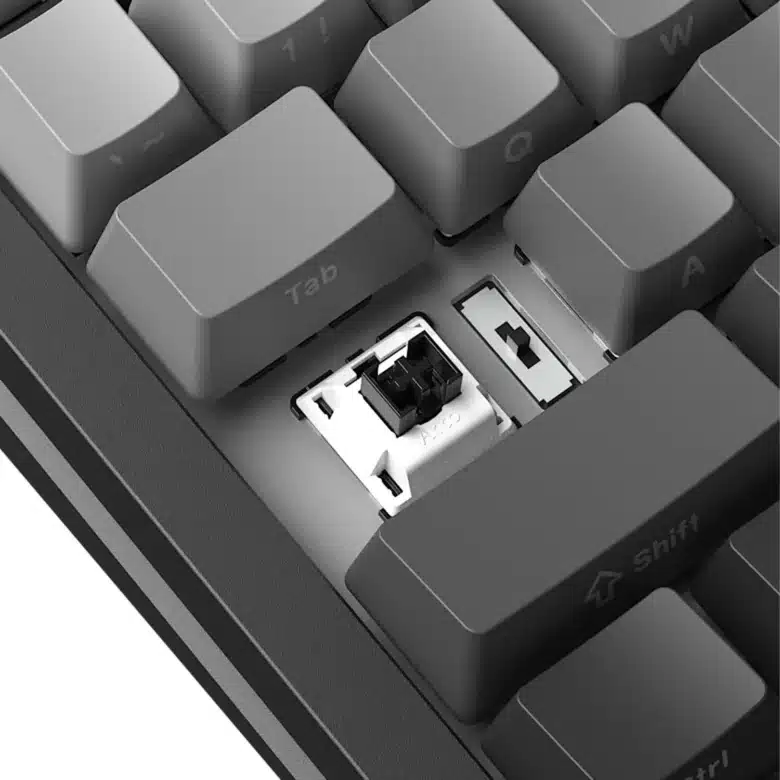
Thanks to the HotSwap-capable PCB, the switches can be easily replaced without soldering using the supplied keyswitch puller, which greatly simplifies modularity. The PCB also supports N-key rollover, which means that all keystrokes can be registered, regardless of how many keys are pressed at the same time. N-key rollover is also to be expected as standard nowadays.
MonsGeek Driver
- Configuration of RGB lighting
- Creating macros
- Updating the firmware
- UI in need of improvement
The MonsGeek Driver is a software, similar to the Akko Cloud Driver, with which you can make keyboard settings directly on the computer. In the MonsGeek Driver, it is possible to adjust the backlighting, set macros, update the keyboard firmware and much more.
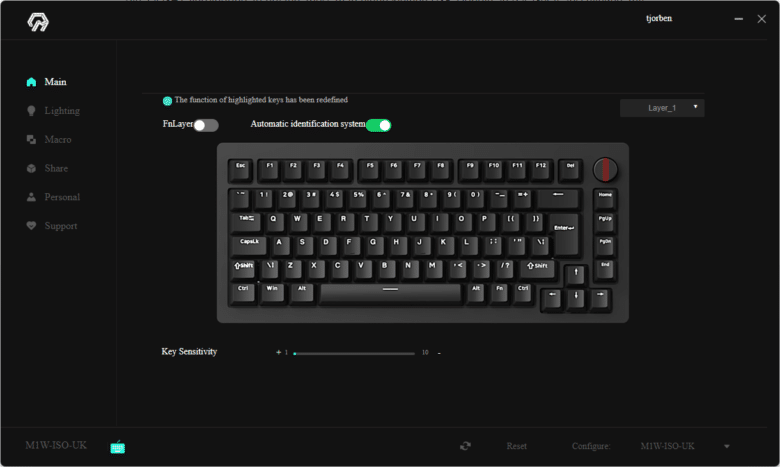
Apart from the functions, however, the UI of the MonsGeek Driver could still be improved. The font (presumably Times New Roman) simply does not match the interface. It seems as if a font was never actively selected, which means that Windows uses a fallback font here. In general, I would have preferred the M1W to have support for the QMK VIA configuration software, such as the MonsGeek M1 keyboard. Compared to the MonsGeek Driver, VIA is a far more comprehensive and sophisticated piece of software.
Ergonomics
- No focus on ergonomics
- Sloping key layout
- Pleasant shape of the keycaps
- Palm rest is recommended
An important aspect for the health and comfort of the hands and wrists is the ergonomics of a keyboard, i.e. how well it adapts to the natural position of the fingers and hands. As we spend more and more time at the computer and keyboard, it is important to choose a keyboard that makes typing comfortable. The MonsGeek M1W showed some ergonomic features in the test, but was not specifically designed with ergonomics in mind.
For example, the keyboard is tilted slightly forwards, which relieves pressure on the wrists. The keys are also slightly curved to follow the natural curves of the fingers. In addition, the keys have a comfortable keystroke and sufficient key spacing, which reduces the error and fatigue rate.

To improve the ergonomics even further, I can only recommend a palm rest. As the keyboard is slightly higher, the palm rest helps to compensate for the difference in height between the palm of the hand and the fingers. This significantly reduces the strain on the carpal tunnel.
Keycaps
- Double-shot PBT
- Gray shades
- Lateral labeling
- Pleasant shape
The keycaps of the MonsGeek M1W keyboard are made of double-shot PBT plastic, which offers high durability and a pleasant feel. The font on the keycaps is clear and easy to read. Thanks to the side lettering, there is no risk of the lettering being damaged by typing over time – although the double-shot PBT process is highly resistant to fading anyway. The keycaps are easy to remove using the keycap puller supplied and can be replaced or cleaned if necessary. The keycaps have a slight curvature that adapts to the shape of the fingers and enables a comfortable typing experience.

Switches
- V3 Piano Pro Switches from Akko
- Linear
- 45 g ± 5 g pressure resistance
- Boxed Cherry MX-style stems
- Pre-lubed
- Low volume
The most important aspect of a mechanical keyboard are the switches, which are located under the keys and are mainly responsible for the typing feel and sound. The MonsGeek M1W features the linear V3 Piano Pro switches from Akko. With a pressure resistance of 45 g ± 5 g, the V3 Piano Pro switches are one of the heavier models. They are similar to the popular Cherry MX Black switches, but have slightly less pressure resistance and feature box stems instead of the classic Cherry MX stems. The box stems ensure improved stability and therefore less wobbly keycaps. This makes them ideal for typing.

As the V3 Piano Pro Switches are linear switches, they are the quietest type of mechanical switch. As mechanical switches, they are of course still louder than a membrane keyboard, which is unsuitable for some workplaces. Nevertheless, the MonsGeek M1W test showed it to be a quiet mechanical keyboard.
The V3 Piano Pro switches, which are an upgrade of the older piano switches, are supplied already lubricated. This reduces the friction of the moving part on the housing and improves the acoustics when typing. Due to their linear profile, the V3 Piano Pro Switches have no pressure point in the release curve. They also have no perceptible or audible click. The switches are said to have a service life of 50 million keystrokes.
Here is a recording of the typing sound of the MonsGeek M1W:
Conclusion of the MonsGeek M1W test
For a price of 139.99 € at the time of writing, the MonsGeek M1W keyboard is below the price range that other manufacturers charge for comparable keyboards. For example, the Keychron Q1 Max, which is also made of aluminum and supports both wired and wireless use, currently costs $189.00. Therefore, the M1W is an affordable choice for those interested in a high-quality mechanical keyboard that values a metal chassis.
The excellent workmanship and the generous scope of delivery make the MonsGeek M1W a durable keyboard that is fully customizable and expandable. Only the software support could be more versatile and, above all, more open.
MonsGeek M1W
Scope of delivery
Design & workmanship
Features
Ergonomics
Keycaps
Switches
90/100
Versatile mechanical keyboard in a stylish aluminum design with a competitive price.



